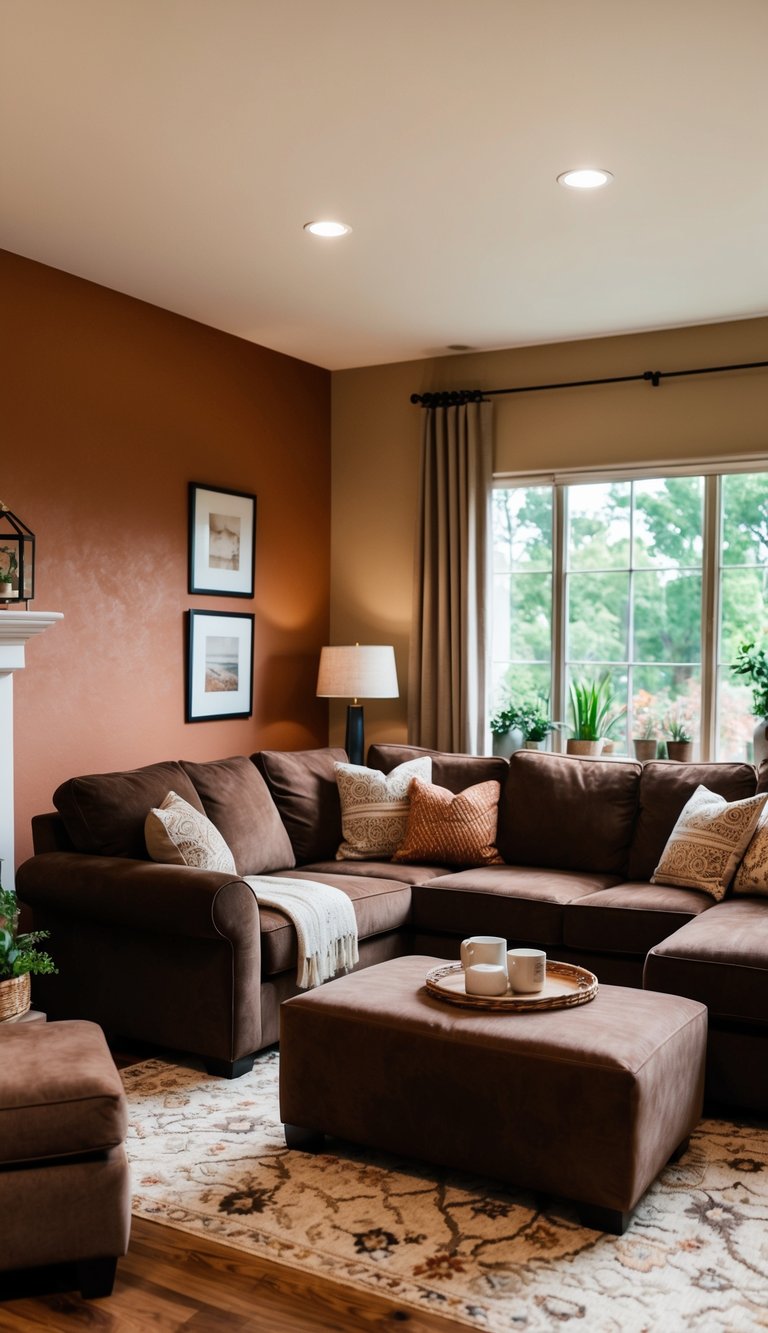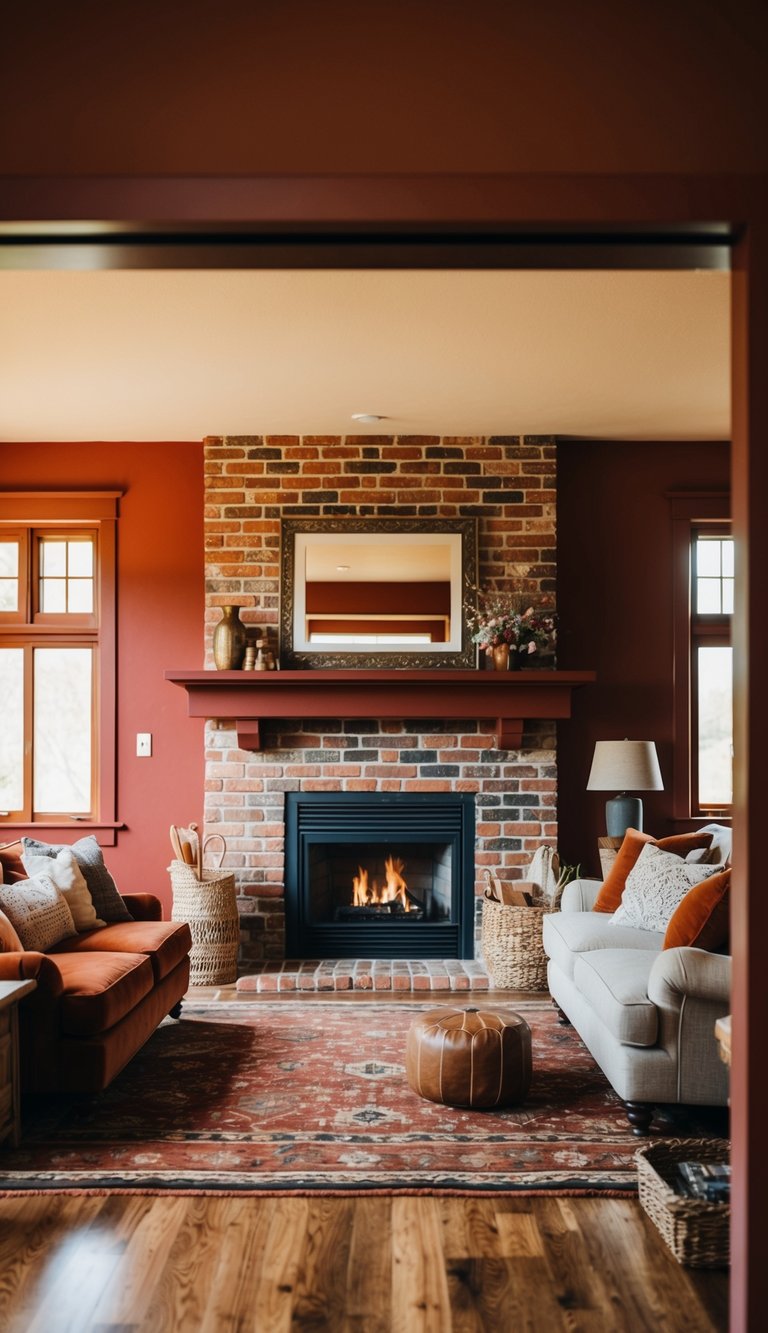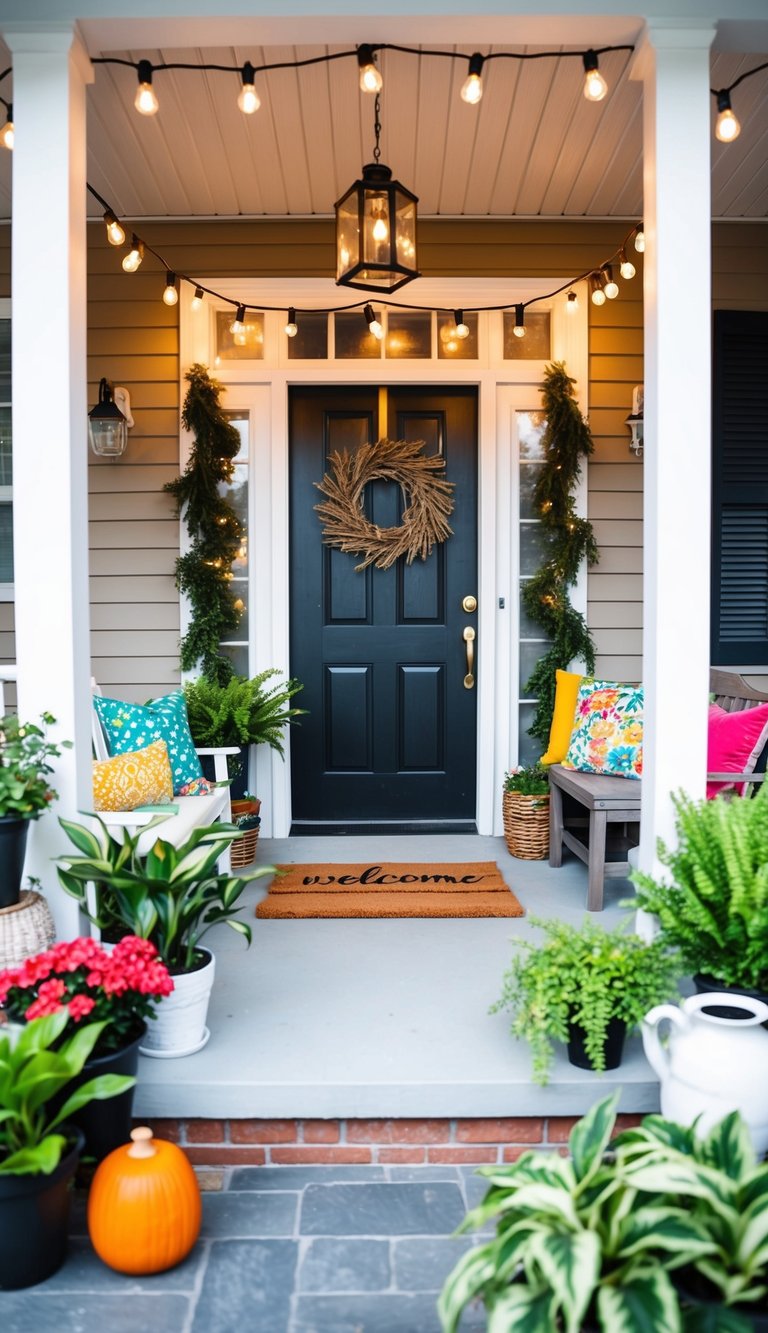Looking to transform your home entryway into a more functional space? These MudRoom Cabinets Ideas are the perfect solution for keeping your entrance organized while adding style to your home. These versatile storage solutions help you manage everyday clutter from shoes, coats, backpacks, and outdoor gear that typically pile up near your door.
Mudroom cabinets come in many styles, from built-in units to simple DIY projects that fit your space and budget. You can choose from options like lockers, benches with storage, or Shaker-style cabinets depending on your needs. Whether you have a dedicated mudroom or just a small entryway, adding the right cabinets can make a big difference in how your home functions day to day.
1) Incorporate a bench with hidden storage
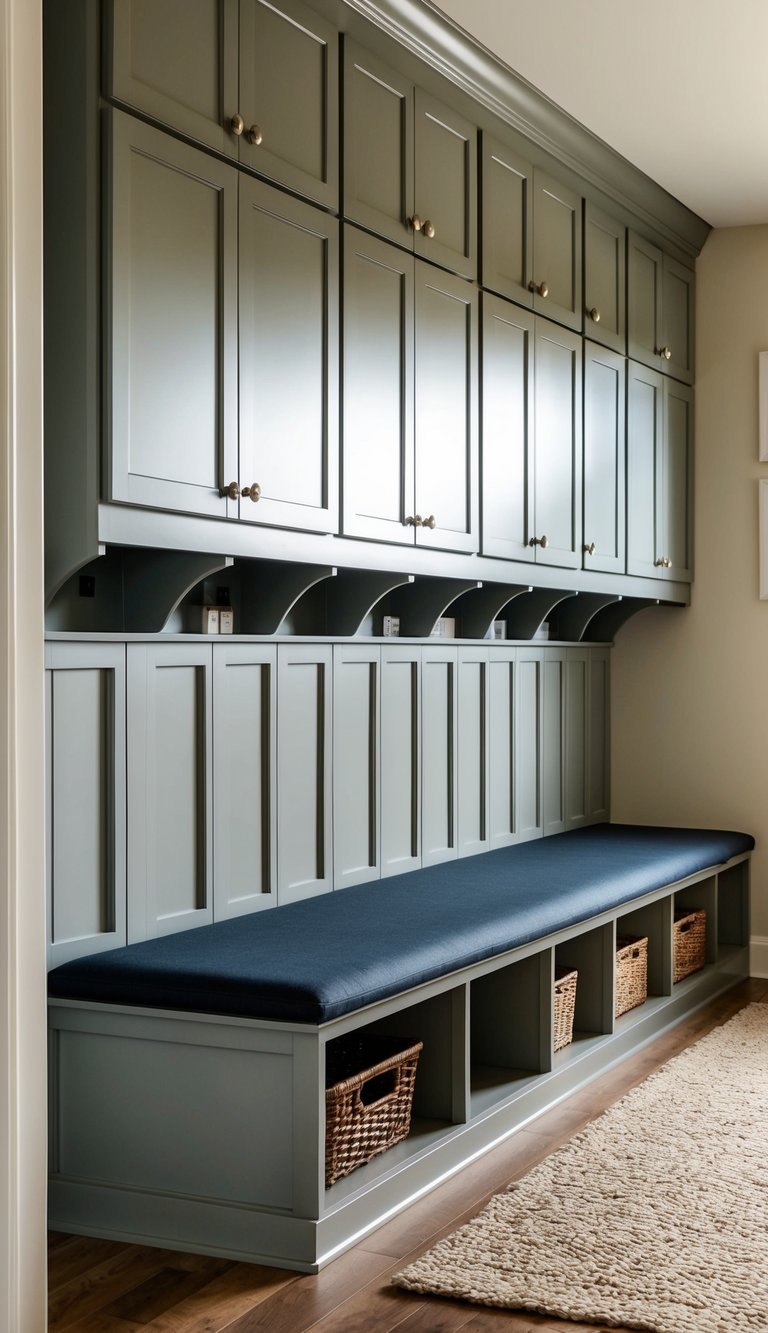
A mudroom bench with hidden storage is like a secret weapon for keeping your space tidy. You can sit down to take off your shoes while having a place to stash items out of sight. This smart design combines function and style in one compact unit.
The bench can have lift-up seating that reveals storage space underneath. This is perfect for seasonal items like hats, gloves, and scarves that you don’t need all year round. You can also use this space for shoes, sports equipment, or pet supplies.
Search for Mud Room Cabinets Ideas at Amazon
Another option is to build drawers beneath the bench. These make it easy to organize smaller items and keep them dust-free. You can label the drawers for each family member or by item type.
For a simple solution, try a bench with cubbies underneath. These open spaces are great for baskets that hold shoes, bags, or other everyday items. The baskets can be pulled out easily when needed.
When designing your mudroom bench, make sure it fits your specific needs. Consider how much storage you require and what items you’ll be storing.
2) Utilize tall cabinets for vertical organization
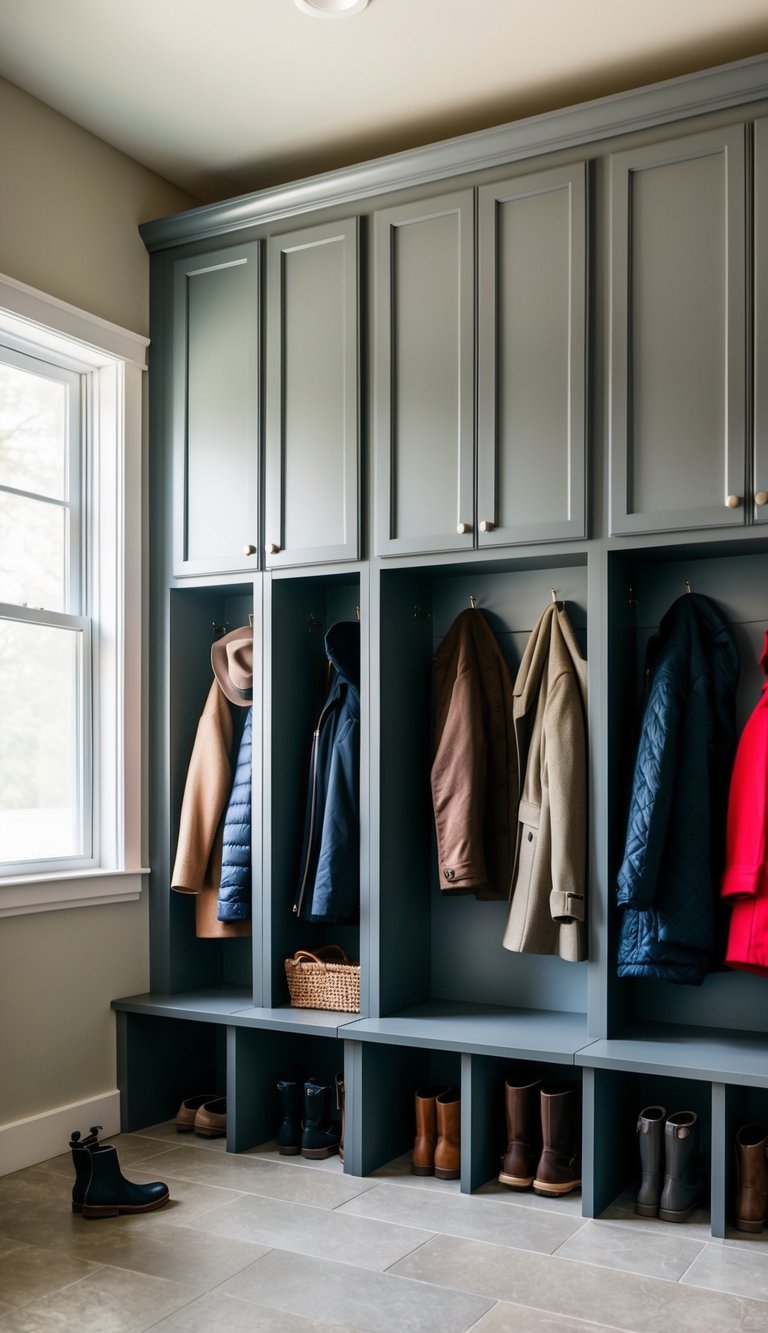
Got limited floor space? Look up! Tall cabinets are your best friends for maximizing vertical storage in your mudroom. These cabinets can stretch from floor to ceiling, giving you tons of space for all your seasonal gear.
For mudrooms with high ceilings (like 10 feet), tall cabinets make perfect sense. You can store less-used items like holiday decorations or seasonal sports equipment on the upper shelves. Keep everyday items at eye level for easy access.
Consider adding adjustable shelving inside your tall cabinets. This lets you customize the space based on what you need to store. Bulky winter coats need more room than summer hats and sunscreen.
Don’t forget about the cabinet doors! Add hooks or small organizers to the inside for even more storage possibilities. This works great for keys, dog leashes, or small accessories.
If custom floor-to-ceiling cabinetry seems too expensive, try combining pre-made cabinets with decorative storage baskets on top. This gives you the tall storage look without the custom price tag.
3) Opt for open cubbies for easy access

Open cubbies are perfect for busy families who need quick access to their stuff. When you’re rushing out the door in the morning, you don’t want to struggle with cabinet doors or drawers.
Without doors in the way, you can grab hats, gloves, or scarves in seconds. You can also see everything at a glance, making it easier to find what you need.
For the top row of cubbies, consider adding baskets to keep smaller items organized. This gives you the benefits of open storage while still keeping things tidy.
The space below your cubbies is perfect for hooks where you can hang coats, backpacks, and other items. Some homeowners even hang additional baskets from these hooks for even more flexible storage.
While some people worry about open storage looking messy, the trade-off in convenience is worth it. After all, the main purpose of a mudroom is functionality, not perfect display.
If you’re repurposing an old media cabinet, try removing the doors and internal shelves. Then add new dividers to create open cubbies that work for your family’s needs.
4) Choose cabinetry with doors to hide clutter
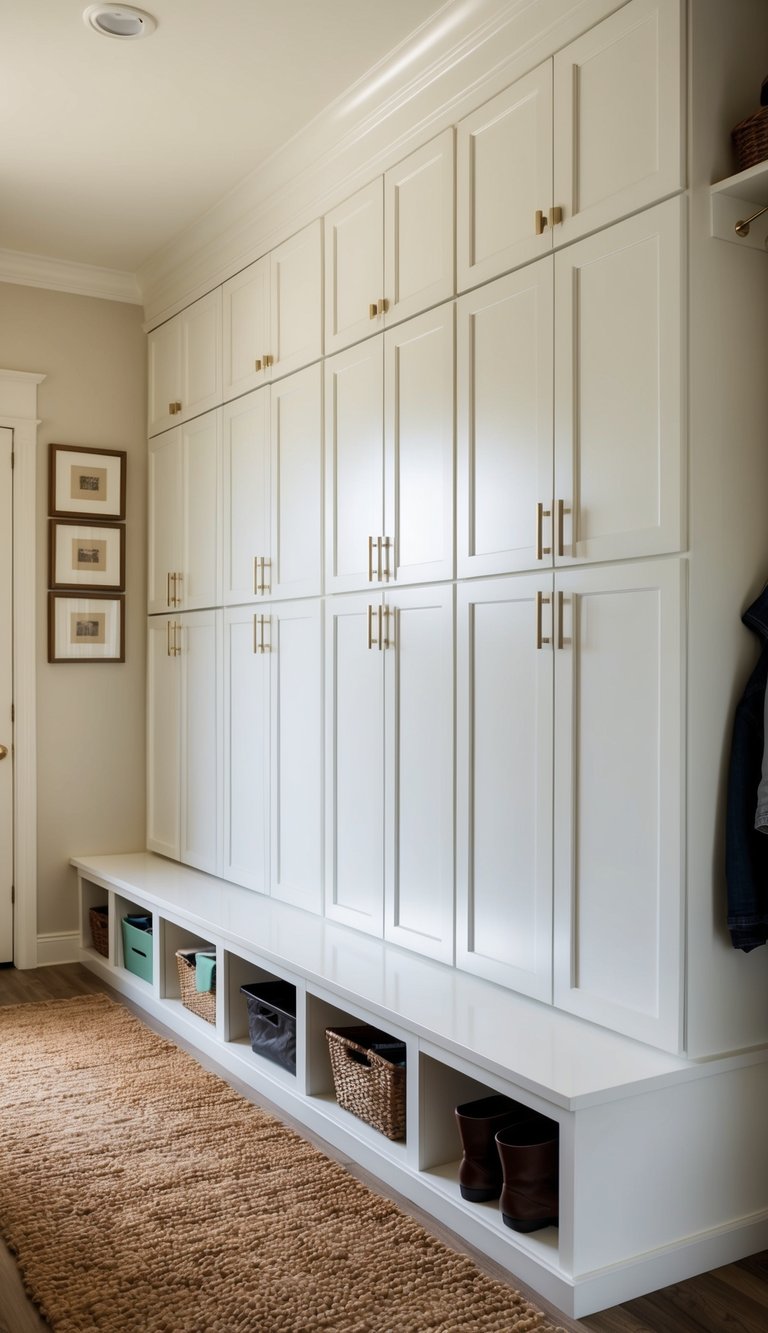
Mudrooms can quickly become messy catchalls for your family’s belongings. Closed cabinets offer a simple solution to keep this chaos hidden from view.
When guests arrive, you won’t need to worry about them seeing piles of shoes, sports equipment, or pet supplies. Just close the cabinet doors, and your mudroom instantly looks neat and organized.
Door styles can match your home’s aesthetic. Shaker-style doors offer a timeless look, while flat-panel doors give a more modern feel. You can even add glass panels if you want to see what’s inside without opening doors.
Consider cabinets with adjustable shelving inside. This lets you customize the space based on what you need to store, from tall boots to small accessories.
For mudrooms that double as laundry areas, cabinets can hide detergents, dryer sheets, and cleaning supplies. This keeps potentially hazardous items away from children and pets.
Adding soft-close hinges prevents slamming and makes the cabinets last longer. These small details make a big difference in how your mudroom functions day to day.
5) Install hooks for coats and bags

Hooks are super useful in any mud room. They give you a quick place to hang coats, backpacks, and bags as soon as you walk in the door.
You can mount hooks at different heights so everyone in the family can reach them. Lower hooks work great for kids, while higher ones are perfect for adults’ longer coats.
Consider using sturdy hooks that can handle heavy winter coats and wet raincoats. Metal hooks tend to last longer than plastic ones and can hold more weight.
Space your hooks about 12 inches apart to give each coat room to dry properly. Too close together and your stuff will stay damp longer.
Some people like to install a row of hooks under a shelf, which gives you two storage options in one space. The shelf holds hats or small items while coats hang below.
Decorative hooks can add style to your mud room. Choose ones that match your cabinets or go with something fun that adds personality to the space.
Don’t forget to place hooks at a height that keeps long coats from dragging on the floor. About 5-6 feet from the ground works well for most adult coats.
6) Include a shoe rack or cubbies for shoes
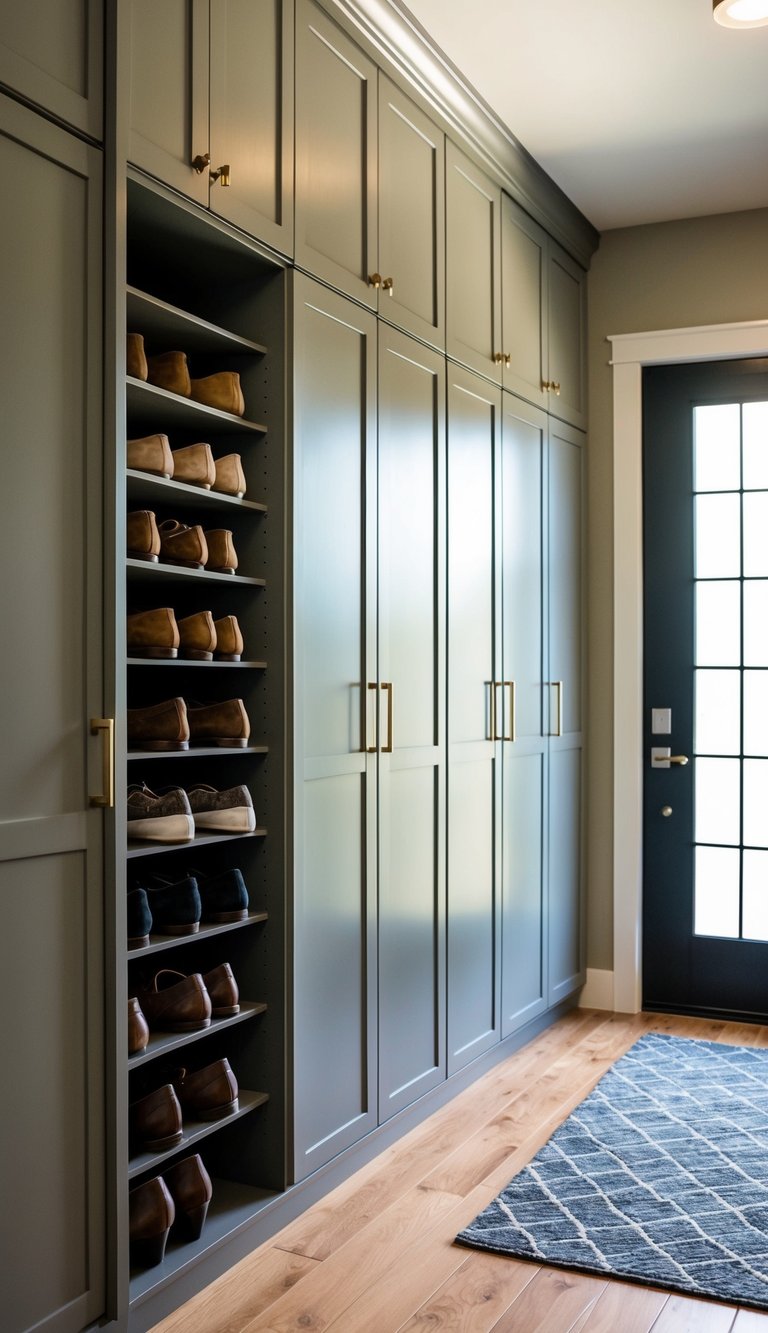
Shoes often create the most clutter in mudrooms. Adding dedicated shoe storage helps keep your space tidy and functional. You can choose between open cubbies, closed cabinets, or pull-out drawers depending on your preference.
For families, individual cubbies work great because everyone can have their own space. You might want to consider taller sections for boots and shorter ones for everyday shoes and sandals.
Built-in shelves provide an easy way to organize different types of footwear. They keep shoes visible while maintaining order in your mudroom.
If space is tight, try a bench with storage underneath. This gives you somewhere to sit while putting on or taking off shoes, plus hidden storage.
For wet shoes or boots, consider adding a tray at the bottom of your cabinet. This catches dirt and water, protecting your floors and making cleanup easier.
Pull-out drawers work well for shoes because they let you see everything at once. No more digging through piles to find matching pairs!
Remember to measure your family’s tallest footwear before building or buying storage. Rain boots and winter shoes need more height than flip-flops and sneakers.
7) Add a flip-top bench for extra space
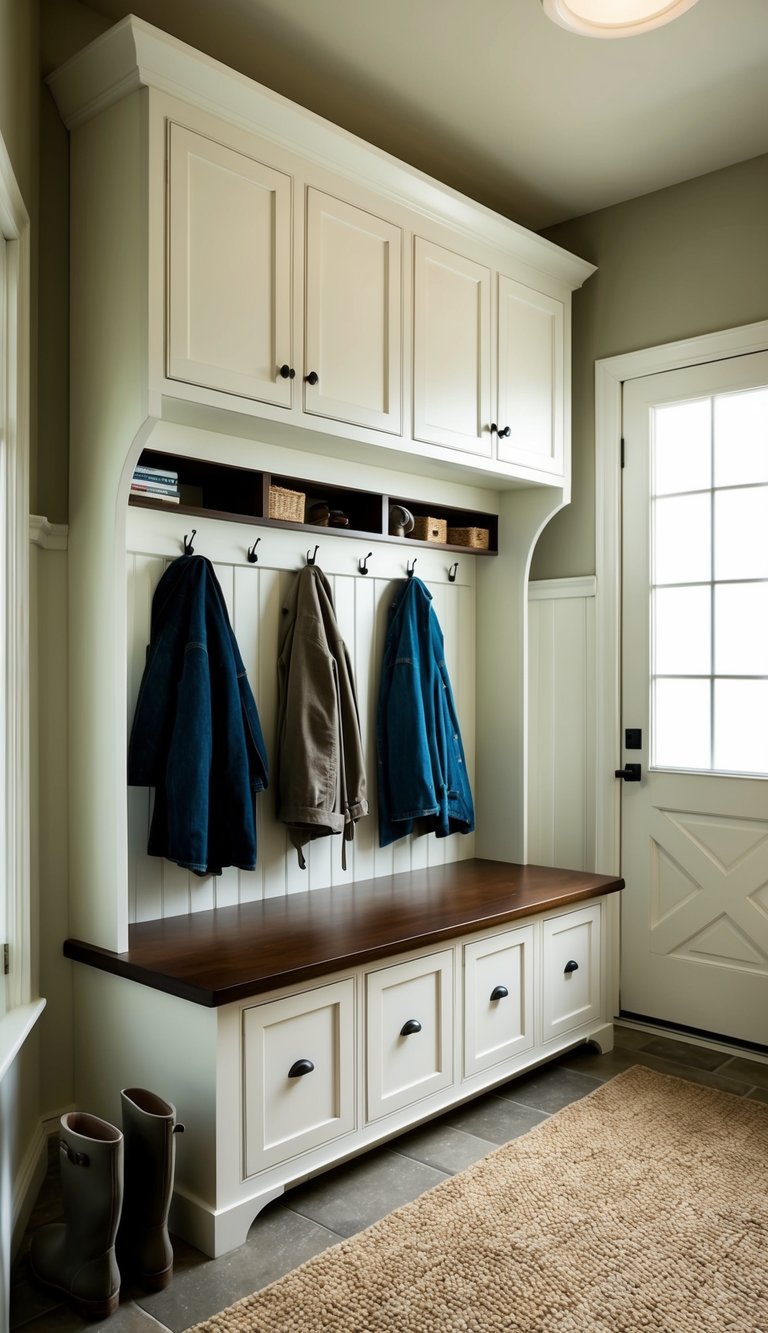
Flip-top benches are mudroom superheroes! They give you a comfy spot to sit while putting on shoes and hide tons of stuff inside. You can easily tuck away seasonal items, sports gear, or pet supplies.
These benches work great in any size mudroom. Even in smaller spaces, they provide valuable storage without taking up extra floor space. You get two functions in one piece of furniture!
Building your own flip-top bench doesn’t require advanced carpentry skills. Many DIY tutorials show how to create one on a budget with basic tools. You can customize the size to fit your specific space.
Make your bench more inviting by adding cushions and pillows on top. This simple touch transforms a storage piece into a decorative element. You can change the pillows seasonally to refresh your mudroom’s look.
Consider adding dividers inside the bench to organize different items. This prevents everything from becoming a jumbled mess. You might create sections for each family member or separate areas for different types of gear.
Your flip-top bench can also include hooks above it or shelving nearby to maximize the storage potential of that wall space.
8) Create a pet station within a cabinet
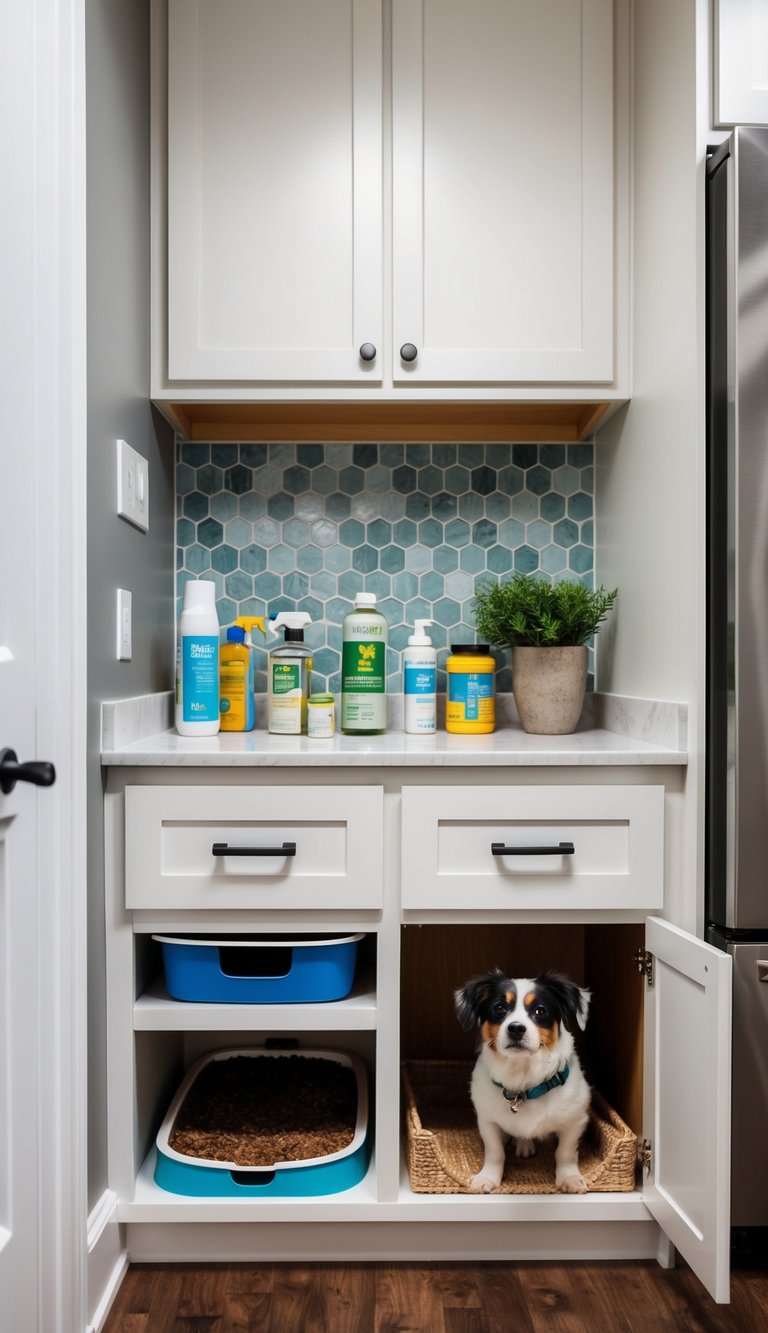
Transform your mudroom into a pet-friendly space by designing a feeding station within a cabinet. This practical solution keeps pet supplies organized and food bowls out of the way when not in use.
You can modify an existing cabinet by adding a sliding drawer at the bottom. This creates a pull-out platform for food and water bowls that can be tucked away after feeding time.
Above the feeding area, add shelves or drawers to store pet food, treats, and medications. Installing hooks inside cabinet doors works great for hanging leashes and collar storage.
For added convenience, place the pet station near your mudroom entrance. This makes it easy to feed your furry friend after walks or grab their leash on the way out.
Consider adding a small bin for pet toys or a dedicated drawer for grooming supplies. Custom dividers help keep everything neat and accessible.
Many home improvement stores sell hardware specifically for creating sliding cabinet bases. You might also find pre-made pet feeding stations that can be installed into existing cabinetry.
9) Use clear bins to categorize items inside cabinets
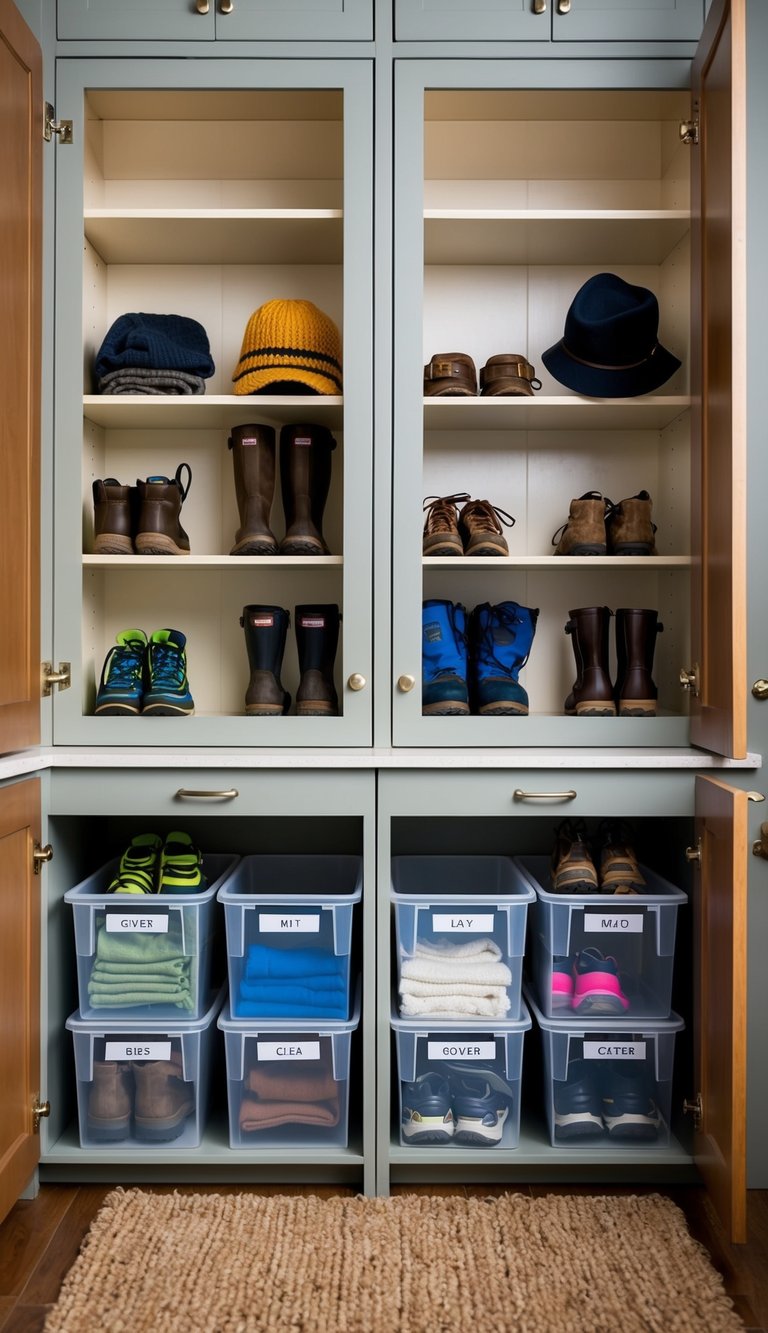
Clear storage bins are perfect for organizing your mudroom cabinets. You can easily see what’s inside without opening them, saving you time when looking for specific items.
Sort your mudroom items by category before placing them in bins. Group similar things together like winter accessories, sports equipment, or cleaning supplies.
Label each bin clearly so everyone in your household knows where things belong. This helps maintain organization and prevents your mudroom from becoming a “dumping room.”
Clear bins with secure lids keep seasonal items dust-free when not in use. They’re perfect for storing gloves, hats, and scarves during warmer months.
Consider giving each family member their own designated bin. This creates personal accountability for belongings and helps prevent clutter buildup.
Stack bins efficiently inside cabinets to maximize storage space. Choose bins that fit your cabinet dimensions and can be easily pulled out when needed.
Use different sized bins for various items. Smaller containers work well for little things like keys and sunglasses, while larger ones can hold bulky winter gear.
10) Combine cabinets with open shelving for versatility
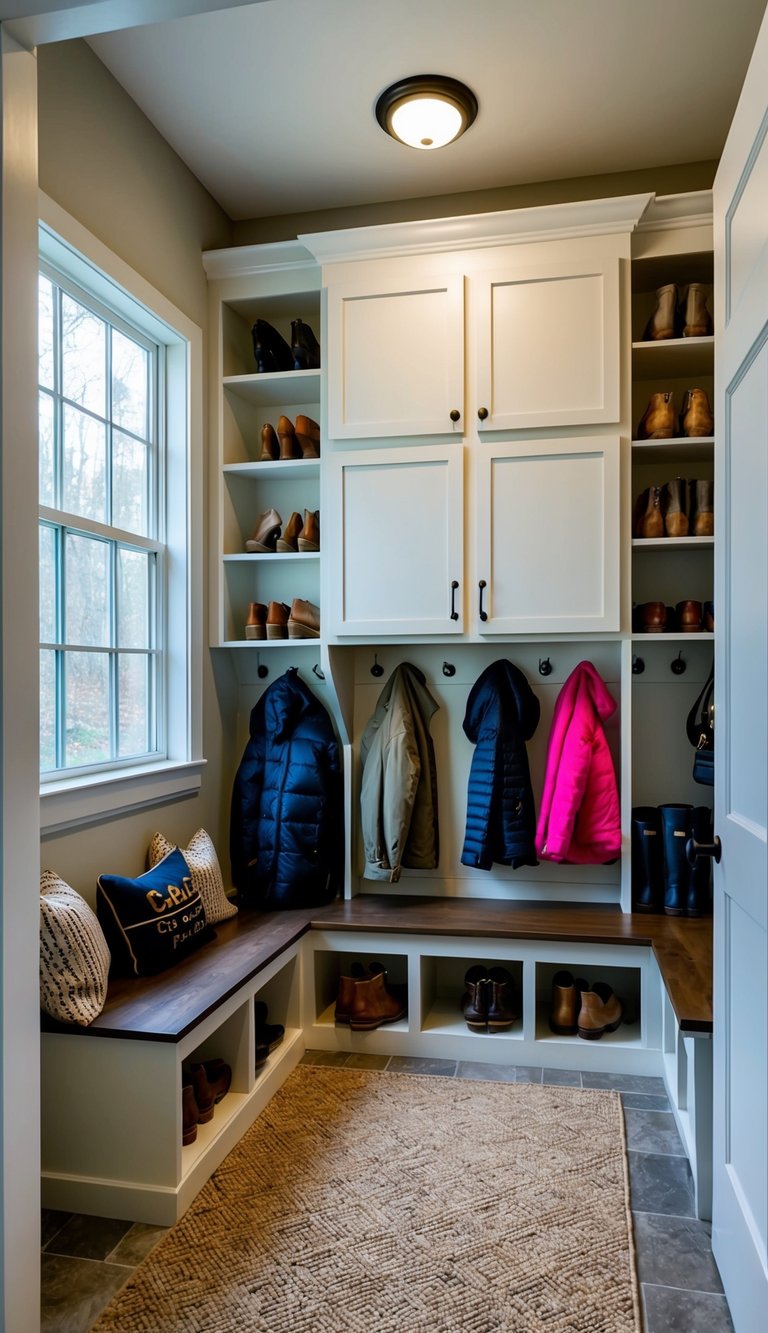
Mixing closed cabinets with open shelving gives you the best of both worlds in your mudroom. You can hide away clutter in cabinets while displaying prettier items on open shelves.
Open shelving is perfect for items you need to grab quickly. Place baskets, decorative boxes, or everyday essentials on these shelves for easy access.
Closed cabinets work great for storing seasonal items or things that might look messy. You don’t want to see winter boots in summer or umbrellas scattered around.
Try placing open shelves at eye level and cabinets below. This arrangement keeps frequently used items visible while hiding away bulkier stuff.
You could also add a few floating shelves above closed cabinets for extra storage. These are great for displaying plants or family photos to warm up the space.
Remember to think about your daily routine when deciding what goes where. Put items you use daily on open shelves and less-used things behind cabinet doors.
This combination approach helps your mudroom stay functional and pretty at the same time. It’s a practical solution that won’t go out of style anytime soon.
Choosing the Right Mud Room Cabinets
Selecting the perfect cabinets for your mud room requires careful thought about materials that can withstand daily wear and storage solutions that fit your family’s lifestyle. Your cabinets need to be both practical and appealing.
Considering Material and Durability
When picking mud room cabinets, durability should be your top priority. This space takes a beating from wet boots, sports gear, and outdoor elements.
Solid wood cabinets offer classic appeal and longevity, though they may require more maintenance. Look for maple or oak which resist dents and scratches well.
Medium-density fiberboard (MDF) with a quality finish provides a budget-friendly alternative that stands up to humidity. Many homeowners choose this option for painted cabinet designs.
For extreme durability, consider cabinets with melamine or laminate finishes. These withstand moisture and are super easy to clean with just a damp cloth.
Don’t forget about hardware! Choose sturdy handles and hinges that can take frequent use without loosening or breaking.
Storage Needs and Functionality
Start by asking what you really need to store in your mud room. Families with kids might want lockers to keep everyone’s items separate and organized.
A bench with storage underneath serves double duty – a place to sit while putting on shoes and hidden storage for seasonal items. This works great in mud rooms of any size.
Include a mix of open and closed storage. Open hooks and shelves keep daily items accessible, while cabinets with doors hide visual clutter and protect rarely-used items from dust.
Consider your specific needs like:
- Drawers for small items like gloves and scarves
- Tall cabinets for brooms and sports equipment
- Cubbies with bins for quick organization
Don’t forget specialty features like a built-in charging station for electronics or a hidden spot for pet supplies. Smart planning now means better organization later!
Incorporating Style and Aesthetics
Your mudroom cabinets should be both functional and beautiful. With the right design choices, this practical space can become a stylish extension of your home that welcomes you every time you enter.
Matching with Existing Decor
When selecting cabinet styles for your mudroom, consider the overall design theme of your home. If you have a farmhouse-style home, shaker cabinets with beadboard panels might be perfect. For modern homes, flat-panel cabinets with sleek hardware create a cohesive look.
Color is crucial too. You can either match your kitchen cabinets for continuity or choose a complementary accent color. Blues and greens are popular choices that hide dirt while adding character.
Materials matter as well. Wood cabinets bring warmth, while painted MDF offers durability and cost savings. For hardware, brushed nickel works well in contemporary spaces, while oil-rubbed bronze suits rustic designs.
Don’t forget about the walls! Shiplap, beadboard, or decorative wallpaper can elevate the space above and around your cabinets.
Adding Personal Touches
Your mudroom cabinets can reflect your personality through thoughtful details. Consider custom labels for each family member’s storage space using chalkboard paint, cute name tags, or color-coding.
Decorative hooks add character while being functional. Choose ones that match your home’s style—wrought iron for rustic spaces or sleek chrome for modern homes.
Display meaningful items on open shelving. Family photos, seasonal decor, or treasured keepsakes make the space feel like home.
Add textiles for warmth and personality. A cushion on your bench in a fun pattern, small rugs, or even curtains to hide open storage can make the space inviting.
Lighting matters too! Install stylish sconces or a small chandelier instead of basic fixtures to elevate the entire look of your mudroom.


